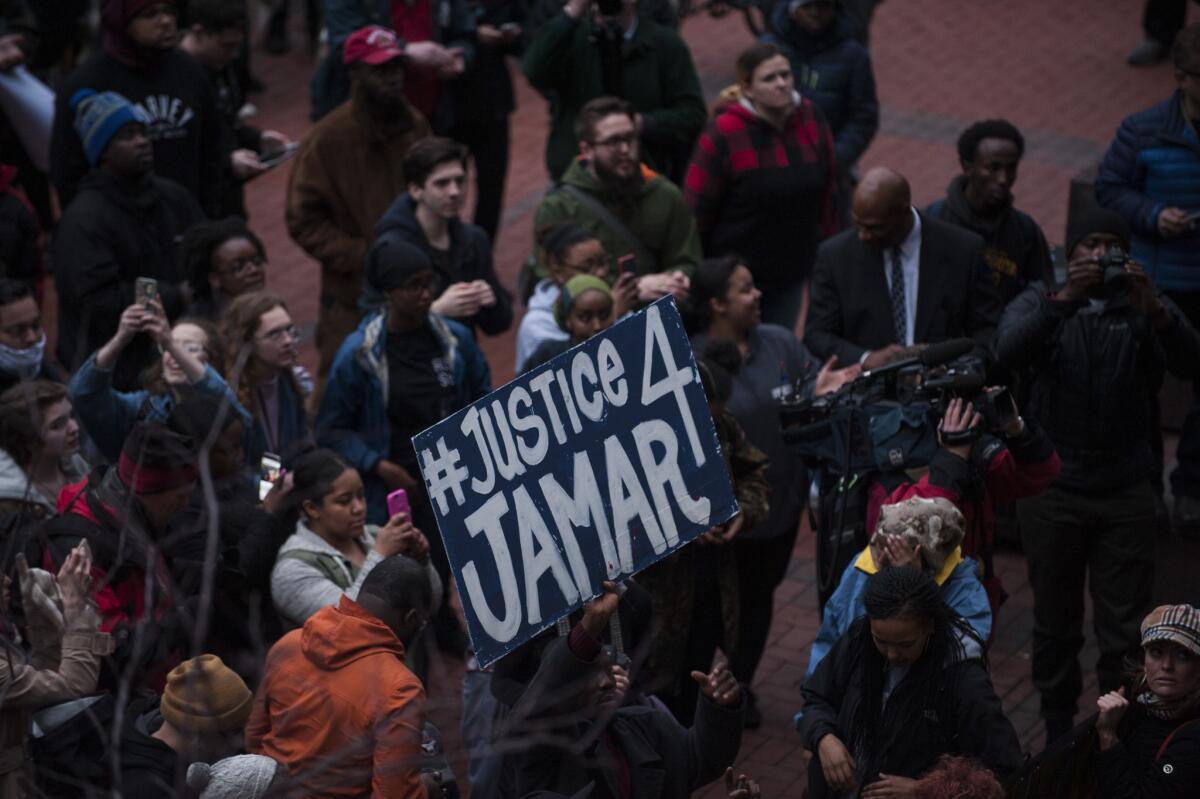Protests but no prosecution: 5 lesser-known shootings by police

Protestors rally outside of Hennepin County Courthouse on Wednesday against the decision by prosecutors not to bring charges against police officers in the November shooting death of Jamar Clark.
- Share via
Most stories of shootings by police have the same ending: The officers involved won’t face criminal charges.
Some cases are well known: Darren Wilson didn’t get indicted for shooting unarmed 18-year-old Michael Brown after a struggle in Ferguson, Mo. The officer who shot and killed 12-year-old Tamir Rice — who was playing with a toy gun in a Cleveland park — also avoided a criminal trial.
But hundreds of other cases with similar outcomes have received less publicity. The pattern is the same: Officers confront a suspect, who is often armed or mentally ill. Prosecutors back the officers and decline to file charges, as happened in a Minneapolis case this week. And activists and family members express disgust.
Here’s a look at several controversial but less-prominent shootings over the last two years that led to protests but not prosecution.
Jamar Clark, 24, Minneapolis
On Nov. 15, two officers responded to an alleged domestic assault in north Minneapolis. Clark, the suspect, was reportedly interfering with the paramedics placing Clark’s girlfriend into an ambulance. The officers wrestled Clark to the ground before one of them shot him in the head.
While angry bystanders at the scene were shouting that Clark, who was unarmed, had been handcuffed when he was shot, Hennepin County Atty. Mike Freeman said there was no evidence to support that claim and that Clark had been reaching for an officer’s gun during the struggle on the ground. “I’m ready to die,” an officer said that Clark told him.
Freeman announced Wednesday that he would not charge the officers, Mark Ringgenberg and Dustin Schwarze.
Activists blasted the decision. “The two officers are the only ones who corroborated this version of events,” the Black Lives Matter Minneapolis chapter tweeted.
Tony Robinson Jr., 19, Madison, Wis.
On March 6, 2015, veteran Officer Matt Kenny was responding to calls that Robinson had assaulted two people and was running through traffic. Kenny followed Robinson into an apartment building, where he said Robinson punched him. Kenny shot Robinson seven times.
Dane County Dist. Atty. Ismael Ozanne announced two months later that “this tragic and unfortunate death was the result of a lawful use of police force and no charges should be brought.”
Robinson’s mother, Andrea Irwin, said she was not surprised by the decision, but said the investigation should have been more thorough. “They could have done a lot,” she said. “What they didn’t do was give my son any respect.”
Kenny was also involved in the 2007 fatal shooting of a suspect waving a pellet gun, a killing that was deemed a “suicide by cop” and led to Kenny receiving a commendation for valor.
Dontre Hamilton, 31, Milwaukee
Hamilton was sleeping in a downtown park on April 30, 2014, when Officer Christopher Manney woke him up and patted him down. The two scuffled. Punches were thrown, witnesses said. Hamilton eventually got ahold of Manney’s baton, according to the district attorney. Manney then fired his gun 14 times, killing Hamilton with shots to the chest.
Milwaukee’s police chief fired Manney for improperly patting down Hamilton, saying his “bad decision-making” created a chain of events that put him in a position where he had to use deadly force.
Milwaukee County Dist. Atty. John Chisholm declined to file charges. “There can be little serious doubt that [Officer] Manney was justified in firing at Dontre Hamilton, who was attacking him with a deadly weapon,” he said in a December 2014 statement announcing his decision.
Hamilton’s family said he was schizophrenic but not violent.
Darrien Hunt, 22, Saratoga Springs, Utah
On Sept. 10, 2014, two officers responded to a report that Hunt was walking in public with a three-foot samurai sword. The officers and Hunt talked before Hunt lunged at them with the sword, officials said. The two officers fired a total of seven shots, and Hunt was fatally shot in the back while running away with the sword in his hand.
Hunt’s family said the sword wasn’t a real weapon, but investigators said it had a pointy end and an edge sharp enough to cut. Swinging it constituted attempted murder or aggravated assault and justified the shooting, said Utah County Atty. Jeff R. Buhman.
Hunt’s aunt, Cindy Moss, told the Los Angeles Times: “All along, we were praying the [prosecutor’s] office would show some integrity and honesty in the case, and apparently they chose not to. It’s disgusting.”
John Crawford, 22, Beavercreek, Ohio
On Aug. 5, 2014, several officers entered the Wal-Mart in the Dayton suburb of Beavercreek after they received calls about a man allegedly pointing a weapon at shoppers. It was Crawford. He had taken an unpackaged air rifle off a shelf and was walking around the store with it — seemingly absentmindedly, as he talked on the phone. The officers fatally shot him.
A grand jury declined to indict the officer who shot Crawford.
He was the victim of “a perfect storm of circumstances” and “didn’t do anything wrong,” Mark Piepmeier, a special prosecutor appointed to handle the case, said after the decision, according to the Guardian.
Michael Wright, an attorney for the Crawford family, said: “We saw a young man in a Wal-Mart doing absolutely nothing wrong and getting shot by police.”
The Associated Press contributed to this report.
More to Read
Sign up for Essential California
The most important California stories and recommendations in your inbox every morning.
You may occasionally receive promotional content from the Los Angeles Times.











